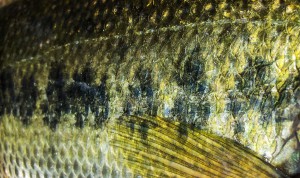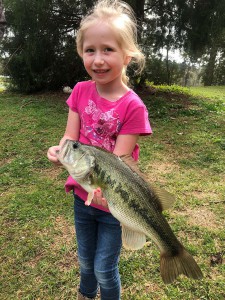By Justin Pickett
It’s time to get serious about catching that trophy bass.
In part one we covered the when, where and how of fishing to bass on beds. Now we’re going to talk about the get, flies and presentations that make for success.
So, you’ve found Ms. Piggy sitting just off of her bed, seemingly staring intently towards her nest and chasing bluegill away from her vicinity. It seems as though she’ll likely eat anything dropped near or onto her bed. What’s next?
First, let’s address your setup. I recommend swinging a 7-9 weight, fast-action rod with an aggressive weight-forward floating line. You’ll need the power in the ass of a beefier rod to help set the hook solidly. I don’t stress so much on reels for bass, as they do a lot more jumping and thrashing than they do any kind of running. I do make sure to hunker down on my drag though, just in case once tries to take me into some trouble nearby. I throw short, beefy leaders when fishing to bass on beds. I need my flies to turn over quickly because I’m doing a lot of close up work in shallow water, so I typically stick with 7.5ft leaders and 12-15lb tippet.
 The second thing we’re going to touch on is your timing. When you decide to hunt for these fish is going to play into your success rate. Your chances are best in the early morning and evening hours. Low light can make these fish a little harder to spot (another reason to always wear polarized sunglasses), but that’s when fish begin to drop their inhibitions and feel less threatened by predators. High sun is a great time for spotting beds and fish, but also makes it a lot easier for the fish to spot you as well. ShadowsI’ve had the glare from a raising fly rod spook many fish in my experience. I’m not saying don’t try during the middle of the day, but the odds aren’t as great. When planning your stalking, try to plan fishing during the first and last few hours of the day, or on overcast days. The other reason for fishing first thing in the morning is the fact that they have had all night to settle in and chill by their bed. This is especially true for bass that see heavy angling pressure.
The second thing we’re going to touch on is your timing. When you decide to hunt for these fish is going to play into your success rate. Your chances are best in the early morning and evening hours. Low light can make these fish a little harder to spot (another reason to always wear polarized sunglasses), but that’s when fish begin to drop their inhibitions and feel less threatened by predators. High sun is a great time for spotting beds and fish, but also makes it a lot easier for the fish to spot you as well. ShadowsI’ve had the glare from a raising fly rod spook many fish in my experience. I’m not saying don’t try during the middle of the day, but the odds aren’t as great. When planning your stalking, try to plan fishing during the first and last few hours of the day, or on overcast days. The other reason for fishing first thing in the morning is the fact that they have had all night to settle in and chill by their bed. This is especially true for bass that see heavy angling pressure.
Thirdly, let’s talk fly patterns. I kind of have a system that I go through when I find a fish on a bed that’s aggressively protecting the bed. My initial presentations are done with a weightless baitfish pattern that often mimics a bluegill or baby bass. Often, this is a #2-1/0 fish mask zonker tied on a B10S hook. It provides good movement and should entice a fish that might be chasing baitfish away from the bed. Also, the slow sink rate and amount of movement can prove irresistible for a big bass to pass up. If that doesn’t work, then I go straight for the bigger, heavier flies. Pat Cohen’s Jiggy Craw is a favorite of mine, as well as clousers and any other weighted creature-like fly. I don’t get terribly hung up on the pattern, but I do change colors often. I’ll often try highly visible colors (like white, orange, or yellow) first and switch to black or olive if those don’t get any attention.
 Regardless of fly pattern, the best way to make your presentation is to throw past the bed and then strip the fly onto the bed. Once the fly reaches the bed, let it fall onto the outer edge of the bed. Let it sit for a few seconds. Shake it a few times. If nothing happens, then drag it into the middle of the bed and give it a little shake. Repeat this until you’ve worked your fly across the entire bed. Now, during this sequence one of three things is going to happen. One, the bass is going to get pissed and inhale your fly. Game, set, match. Awesome! Two, this bass is going to appear interested in your fly, but maybe lose interest and cruise off to continue his/her patrol. If this happens, give it a couple more casts on different parts of the bed. Try dropping it just outside the bed. Try jigging it. Wiggling it. Try anything different in order to give that bass a different look. If the bass still seems to lose interest in the fly, then snip it off and change the color. Was it a natural color? Go bright. Bright? Go natural. White? Try black. Give them something completely new to look at.
Regardless of fly pattern, the best way to make your presentation is to throw past the bed and then strip the fly onto the bed. Once the fly reaches the bed, let it fall onto the outer edge of the bed. Let it sit for a few seconds. Shake it a few times. If nothing happens, then drag it into the middle of the bed and give it a little shake. Repeat this until you’ve worked your fly across the entire bed. Now, during this sequence one of three things is going to happen. One, the bass is going to get pissed and inhale your fly. Game, set, match. Awesome! Two, this bass is going to appear interested in your fly, but maybe lose interest and cruise off to continue his/her patrol. If this happens, give it a couple more casts on different parts of the bed. Try dropping it just outside the bed. Try jigging it. Wiggling it. Try anything different in order to give that bass a different look. If the bass still seems to lose interest in the fly, then snip it off and change the color. Was it a natural color? Go bright. Bright? Go natural. White? Try black. Give them something completely new to look at.
The third thing that may happen is a complete refusal as soon as either your fly hits the bed, or even as soon as your fly hits the water. I’ve seen this happen a ton with heavily pressured fish. Often times what you willl see is the bass (female or male) will cruise off the bed immediately after the fly is presented and then slide into either deep water, or nearby cover if any is available. These fish often return to the bed after a few minutes, but too many more similar presentations will often result in a fish that will blow off the nest and not return until you are long gone. If it appears that you have this situation in front of you, the best thing to do is to downsize. When faced with a spooky fish, I cut my tippet size down to 3x and tie on a dragonfly nymph with bead chain eyes. Even a spooky spawner wants to keep their bed tidy and free of any opportunistic predators. The last thing they want is a dragonfly nymph munching on their newly hatched fry. This smaller fly still poses a threat to the bed, yet isn’t as alarming to the bass itself while still being obtrusive enough to entice a strike. Plus, the much smaller disturbance created during your presentation will help keep your efforts disguised.
 These tips and tricks should certainly help boost your chances of hooking up with Big Mama, but one very important thing is to be persistent. Keep at it. Cover water and keep your eyes peeled. Make multiple presentations, switching up angles, colors, and flies often. I’ve even come back the very next day to fish for the same fish. Fish are moody, so their behavior can turn a one-eighty from day to day. If you completely strike out on a fish, don’t let it haunt you. There are plenty of other big gals hovering over beds all over the country this time of year. Pick a new piece of water and get to work. Just like with any fishing, the more time you put in on the water, the more successful you will be.
These tips and tricks should certainly help boost your chances of hooking up with Big Mama, but one very important thing is to be persistent. Keep at it. Cover water and keep your eyes peeled. Make multiple presentations, switching up angles, colors, and flies often. I’ve even come back the very next day to fish for the same fish. Fish are moody, so their behavior can turn a one-eighty from day to day. If you completely strike out on a fish, don’t let it haunt you. There are plenty of other big gals hovering over beds all over the country this time of year. Pick a new piece of water and get to work. Just like with any fishing, the more time you put in on the water, the more successful you will be.
 Sign Up For Our Weekly Newsletter!
Sign Up For Our Weekly Newsletter!

